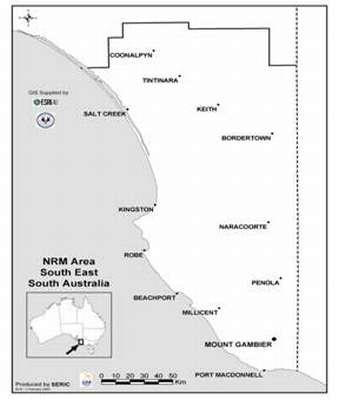Integrated and coordinated total catchment management of air, land, water and biota is a seldom-achieved ambition in karst landscapes. New natural resource legislation in South Australia is moving management of the state's South East karstland closer to this goal.
There are currently 64 boards across South Australia managing issues relating to water resources, pest plants and animals and soil conservation. A new Natural Resources Management (NRM) bill to be debated in Parliament early in 2004, will, if passed, integrate these boards into a single structure, with regional groups developing and implementing integrated NRM plans and administering the delivery of Commonwealth/State programs, such as the Natural Heritage Trust and the National Action Plan for Salinity and Water Quality. As time progresses it is envisioned that other natural resource agencies, such as those involved in land drainage, will also be incorporated into this structure.
NRM regions will be based on water catchment boundaries. In the South East this means that 2.8 million hectares will be under integrated regional management, a large proportion of which is karstland of Miocene Gambier limestone and Pleistocene calcarenite dunes of the Bridgewater Formation. While this NRM structure will not encompass contiguous karst in Victoria, integration should aid existing cross-border cooperation. Significant karst features in the South East include dolines, cenotes, springs, caves, syngenetic karst and pavements, with important biological, fossil and archaeological values. For example, the region's cenotes contain the greatest diversity of stromatolites in the country. The Naracoorte Caves World Heritage Area contains one of richest deposits of Pleistocene vertebrate fossils in the world and is renowned for outstanding examples of extinct megafauna.

In contrast to many other karst areas in Australia, the South East, as well as natural systems, supports a range of important economic activities. Along with local impacts, in areas such as groundwater quality, these activities have involved landscape-scale environmental modification.
The karst and its groundwater resource host a human population of 62,000 and a mosaic of enterprises, including plantation forestry (99,000ha of radiata pine and 24,000ha of Tasmanian blue gum) and agriculture (2,300 farms, covering 1,690,000ha). Native vegetation clearance has been extensive, so that today less than 13% of the original cover remains. Since the late 19th century an extensive land drainage system has been constructed, comprising over 1,780 kilometres of drains and 1,200 associated structures, dramatically changing the hydrology of the region. Drainage developments are still underway, with a new system currently being constructed in the upper South East, to address dry land salinity. Combined with the extent of karst, these activities and impacts pose complex natural resource management challenges.
In March 2001 the South East Natural Resource Consultative Committee (SENRCC) was appointed the interim Integrated Natural Resource Management Group for the region. SENRCC was formed in 1994 to increase NRM coordination among agencies involved in animal and plant control, land use and management, biodiversity, water resources, regional economic development, local government, reserve management, indigenous affairs and community processes. SENRCC is playing an integral role in the transitional processes under the new legislation and has developed the region's NRM plan, which deals with air quality, land, water and biodiversity issues, including groundwater-dependent ecosystems.
An important SENRCC initiative is the Fingers on the Pulse project, which is developing a comprehensive plan for air, land, water and biota monitoring in the region. A more integrated NRM approach, combined with improved monitoring, should help ensure better management of the karstlands of the South East.
As time goes on, it is also hoped that karstland management, as a more regionally relevant 'dialect' of total catchment management, will take hold as an integrating NRM concept in the South East. Rather than simply viewing karst as features in or of the landscape, but as the landscape, such a mindset would help tie together the various facets of natural resource management. At the same time, there is also a regional need to develop mechanisms to more broadly manage and protect the expressions of the karst landscape, such as caves, cenotes and karren, using the concepts and principles of geodiversity and geoconservation.
* Anthony Hele, an ACKMA member, is developing the South East natural resource monitoring plan for SENRCC.